Analysis of Safeguarding and Protection in Health and Social Care
VerifiedAdded on 2023/06/17
|7
|1950
|107
Report
AI Summary
This report provides an overview of safeguarding and protection within the health and social care sector. It discusses the responsibilities of health and social care practitioners in relation to whistleblowing, highlighting the importance of reporting potential harm to ensure patient safety. It examines the practices used by health and social care workers to safeguard both individuals receiving care and themselves, emphasizing the need for a safe environment, DBS checks, and professional conduct. The report also addresses the boundaries of confidentiality, explaining when information can be shared to protect individuals. Furthermore, it explores the benefits of working in partnership to enhance safeguarding and protection efforts, including improved communication, diverse expertise, and better service delivery. The report concludes by reinforcing the significance of safeguarding in protecting the health, well-being, and human rights of service users, and the ethical obligations of practitioners in maintaining confidentiality while prioritizing patient safety. Desklib offers a variety of study tools, including past papers and solved assignments, to support students in their academic endeavors.
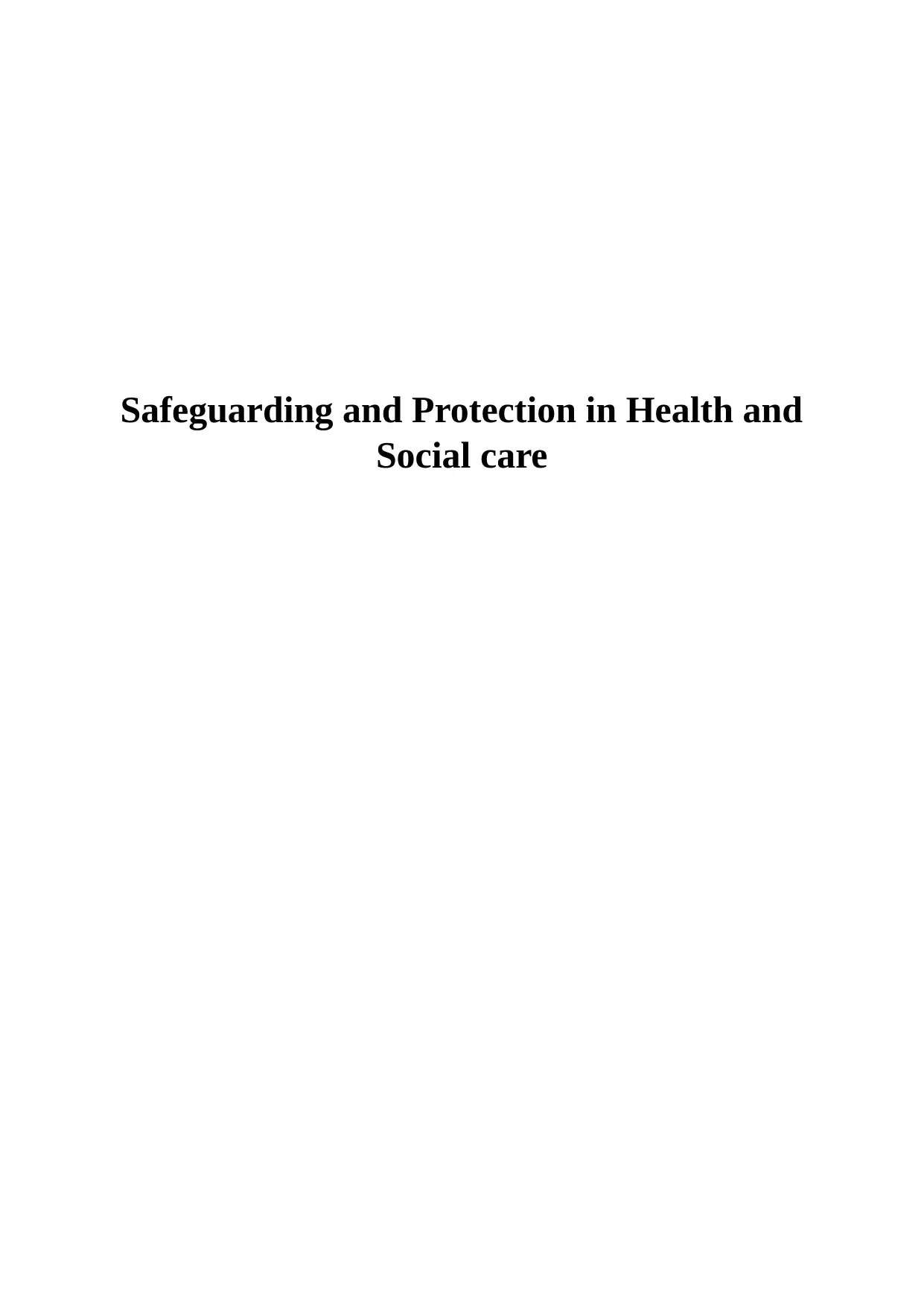
Safeguarding and Protection in Health and
Social care
Social care
Paraphrase This Document
Need a fresh take? Get an instant paraphrase of this document with our AI Paraphraser
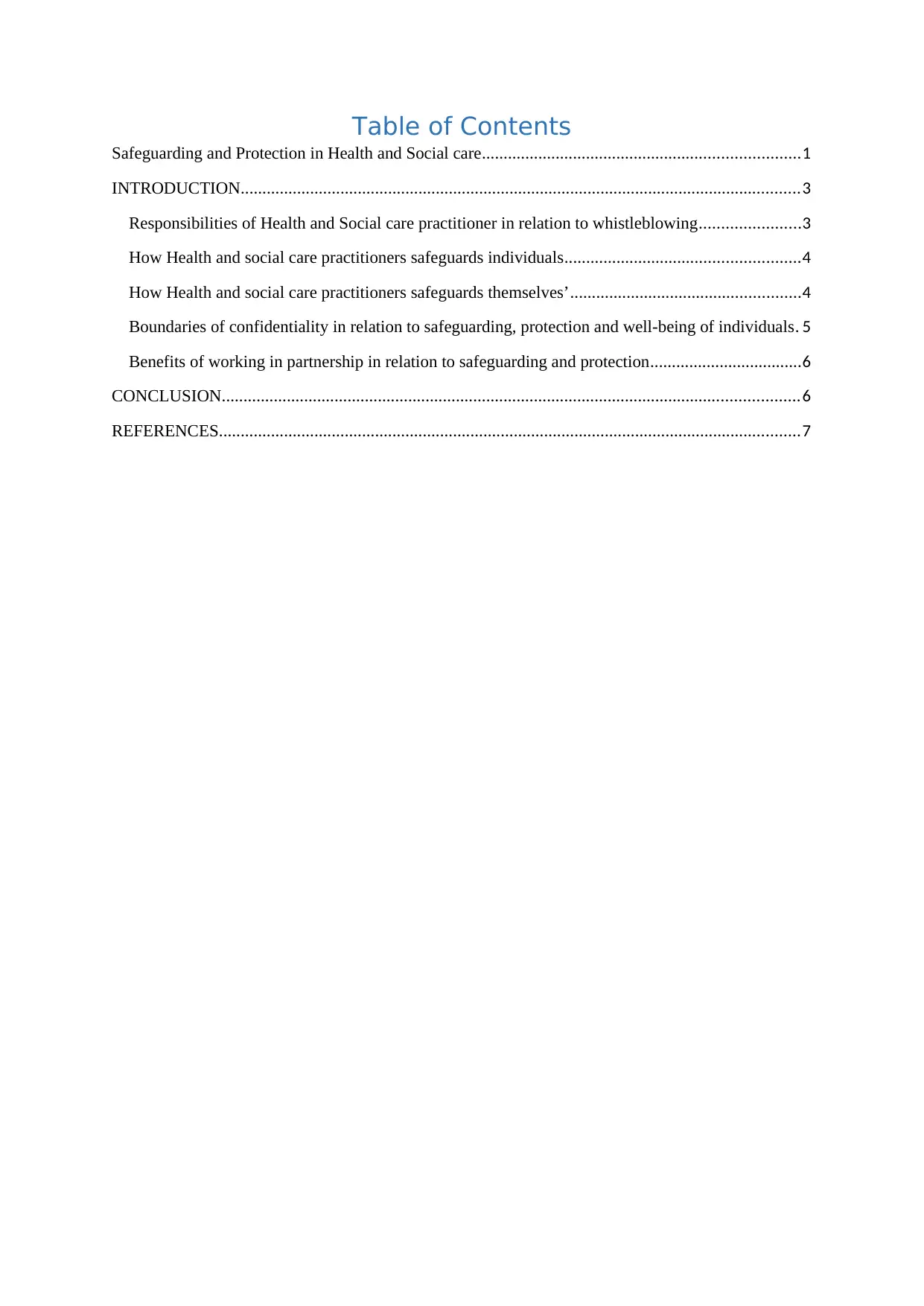
Table of Contents
Safeguarding and Protection in Health and Social care.........................................................................1
INTRODUCTION.................................................................................................................................3
Responsibilities of Health and Social care practitioner in relation to whistleblowing.......................3
How Health and social care practitioners safeguards individuals......................................................4
How Health and social care practitioners safeguards themselves’.....................................................4
Boundaries of confidentiality in relation to safeguarding, protection and well-being of individuals. 5
Benefits of working in partnership in relation to safeguarding and protection...................................6
CONCLUSION.....................................................................................................................................6
REFERENCES......................................................................................................................................7
Safeguarding and Protection in Health and Social care.........................................................................1
INTRODUCTION.................................................................................................................................3
Responsibilities of Health and Social care practitioner in relation to whistleblowing.......................3
How Health and social care practitioners safeguards individuals......................................................4
How Health and social care practitioners safeguards themselves’.....................................................4
Boundaries of confidentiality in relation to safeguarding, protection and well-being of individuals. 5
Benefits of working in partnership in relation to safeguarding and protection...................................6
CONCLUSION.....................................................................................................................................6
REFERENCES......................................................................................................................................7
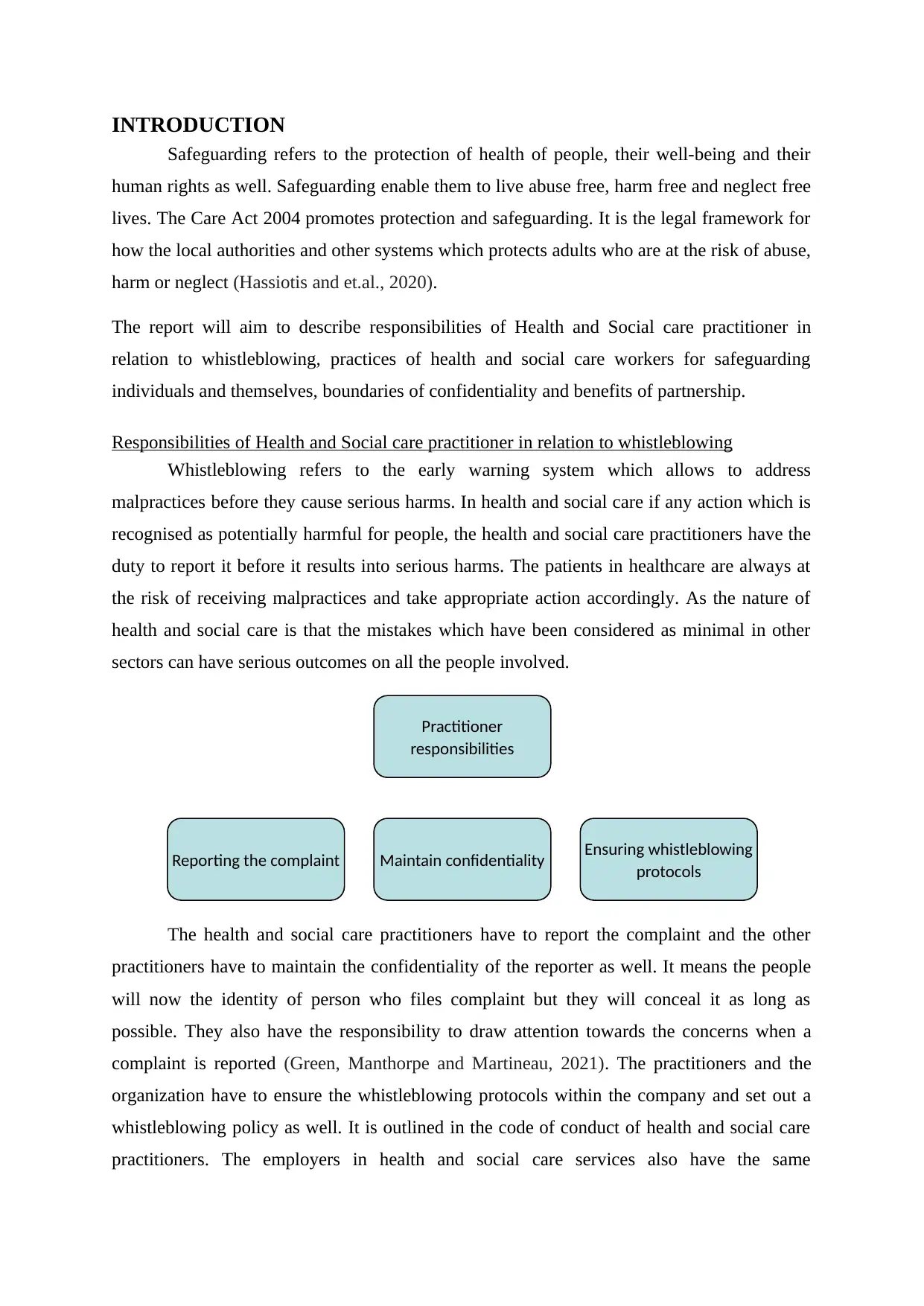
INTRODUCTION
Safeguarding refers to the protection of health of people, their well-being and their
human rights as well. Safeguarding enable them to live abuse free, harm free and neglect free
lives. The Care Act 2004 promotes protection and safeguarding. It is the legal framework for
how the local authorities and other systems which protects adults who are at the risk of abuse,
harm or neglect (Hassiotis and et.al., 2020).
The report will aim to describe responsibilities of Health and Social care practitioner in
relation to whistleblowing, practices of health and social care workers for safeguarding
individuals and themselves, boundaries of confidentiality and benefits of partnership.
Responsibilities of Health and Social care practitioner in relation to whistleblowing
Whistleblowing refers to the early warning system which allows to address
malpractices before they cause serious harms. In health and social care if any action which is
recognised as potentially harmful for people, the health and social care practitioners have the
duty to report it before it results into serious harms. The patients in healthcare are always at
the risk of receiving malpractices and take appropriate action accordingly. As the nature of
health and social care is that the mistakes which have been considered as minimal in other
sectors can have serious outcomes on all the people involved.
The health and social care practitioners have to report the complaint and the other
practitioners have to maintain the confidentiality of the reporter as well. It means the people
will now the identity of person who files complaint but they will conceal it as long as
possible. They also have the responsibility to draw attention towards the concerns when a
complaint is reported (Green, Manthorpe and Martineau, 2021). The practitioners and the
organization have to ensure the whistleblowing protocols within the company and set out a
whistleblowing policy as well. It is outlined in the code of conduct of health and social care
practitioners. The employers in health and social care services also have the same
Practitioner
responsibilities
Reporting the complaint Maintain confidentiality Ensuring whistleblowing
protocols
Safeguarding refers to the protection of health of people, their well-being and their
human rights as well. Safeguarding enable them to live abuse free, harm free and neglect free
lives. The Care Act 2004 promotes protection and safeguarding. It is the legal framework for
how the local authorities and other systems which protects adults who are at the risk of abuse,
harm or neglect (Hassiotis and et.al., 2020).
The report will aim to describe responsibilities of Health and Social care practitioner in
relation to whistleblowing, practices of health and social care workers for safeguarding
individuals and themselves, boundaries of confidentiality and benefits of partnership.
Responsibilities of Health and Social care practitioner in relation to whistleblowing
Whistleblowing refers to the early warning system which allows to address
malpractices before they cause serious harms. In health and social care if any action which is
recognised as potentially harmful for people, the health and social care practitioners have the
duty to report it before it results into serious harms. The patients in healthcare are always at
the risk of receiving malpractices and take appropriate action accordingly. As the nature of
health and social care is that the mistakes which have been considered as minimal in other
sectors can have serious outcomes on all the people involved.
The health and social care practitioners have to report the complaint and the other
practitioners have to maintain the confidentiality of the reporter as well. It means the people
will now the identity of person who files complaint but they will conceal it as long as
possible. They also have the responsibility to draw attention towards the concerns when a
complaint is reported (Green, Manthorpe and Martineau, 2021). The practitioners and the
organization have to ensure the whistleblowing protocols within the company and set out a
whistleblowing policy as well. It is outlined in the code of conduct of health and social care
practitioners. The employers in health and social care services also have the same
Practitioner
responsibilities
Reporting the complaint Maintain confidentiality Ensuring whistleblowing
protocols
⊘ This is a preview!⊘
Do you want full access?
Subscribe today to unlock all pages.

Trusted by 1+ million students worldwide
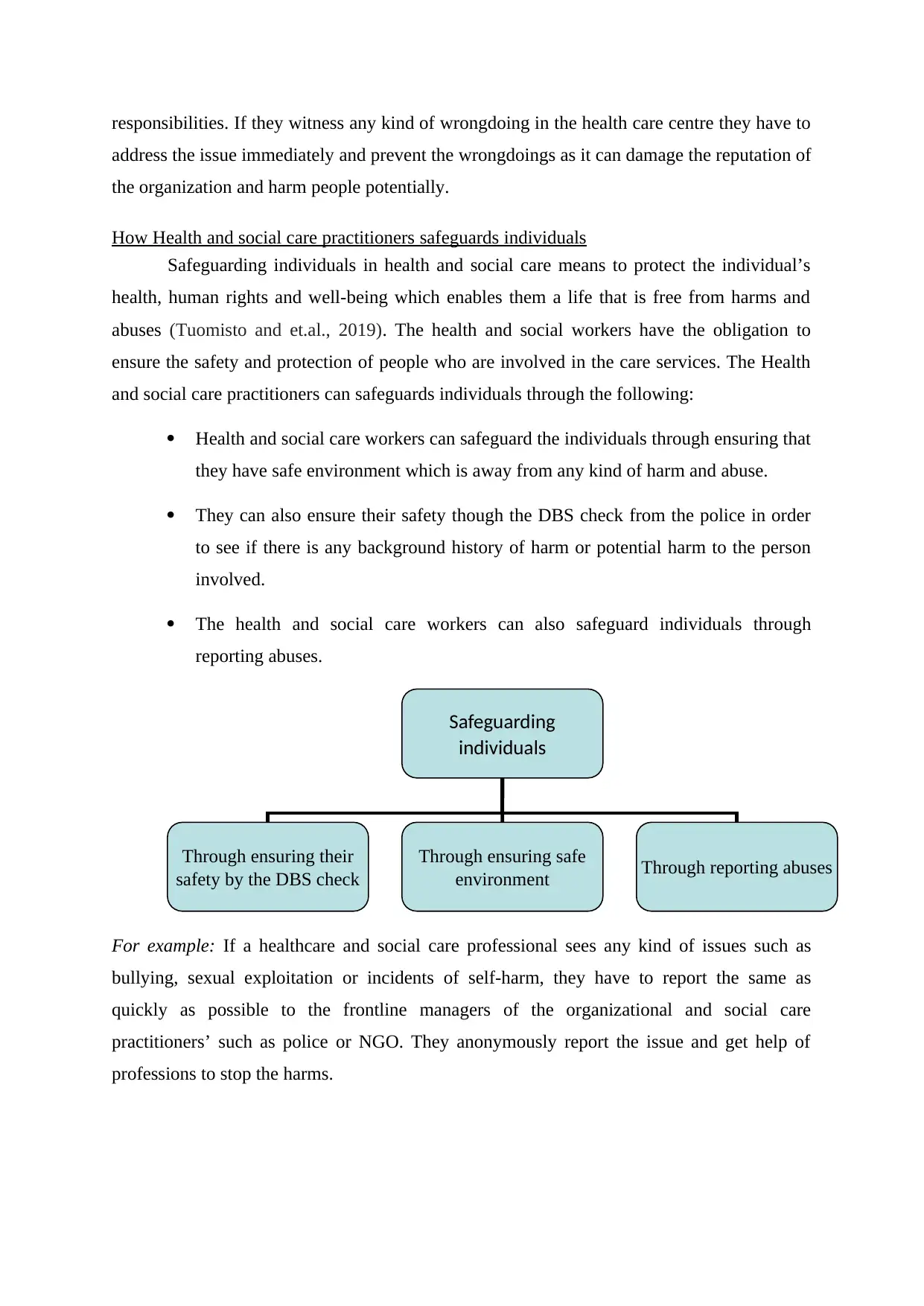
responsibilities. If they witness any kind of wrongdoing in the health care centre they have to
address the issue immediately and prevent the wrongdoings as it can damage the reputation of
the organization and harm people potentially.
How Health and social care practitioners safeguards individuals
Safeguarding individuals in health and social care means to protect the individual’s
health, human rights and well-being which enables them a life that is free from harms and
abuses (Tuomisto and et.al., 2019). The health and social workers have the obligation to
ensure the safety and protection of people who are involved in the care services. The Health
and social care practitioners can safeguards individuals through the following:
Health and social care workers can safeguard the individuals through ensuring that
they have safe environment which is away from any kind of harm and abuse.
They can also ensure their safety though the DBS check from the police in order
to see if there is any background history of harm or potential harm to the person
involved.
The health and social care workers can also safeguard individuals through
reporting abuses.
For example: If a healthcare and social care professional sees any kind of issues such as
bullying, sexual exploitation or incidents of self-harm, they have to report the same as
quickly as possible to the frontline managers of the organizational and social care
practitioners’ such as police or NGO. They anonymously report the issue and get help of
professions to stop the harms.
Safeguarding
individuals
Through ensuring their
safety by the DBS check
Through ensuring safe
environment Through reporting abuses
address the issue immediately and prevent the wrongdoings as it can damage the reputation of
the organization and harm people potentially.
How Health and social care practitioners safeguards individuals
Safeguarding individuals in health and social care means to protect the individual’s
health, human rights and well-being which enables them a life that is free from harms and
abuses (Tuomisto and et.al., 2019). The health and social workers have the obligation to
ensure the safety and protection of people who are involved in the care services. The Health
and social care practitioners can safeguards individuals through the following:
Health and social care workers can safeguard the individuals through ensuring that
they have safe environment which is away from any kind of harm and abuse.
They can also ensure their safety though the DBS check from the police in order
to see if there is any background history of harm or potential harm to the person
involved.
The health and social care workers can also safeguard individuals through
reporting abuses.
For example: If a healthcare and social care professional sees any kind of issues such as
bullying, sexual exploitation or incidents of self-harm, they have to report the same as
quickly as possible to the frontline managers of the organizational and social care
practitioners’ such as police or NGO. They anonymously report the issue and get help of
professions to stop the harms.
Safeguarding
individuals
Through ensuring their
safety by the DBS check
Through ensuring safe
environment Through reporting abuses
Paraphrase This Document
Need a fresh take? Get an instant paraphrase of this document with our AI Paraphraser
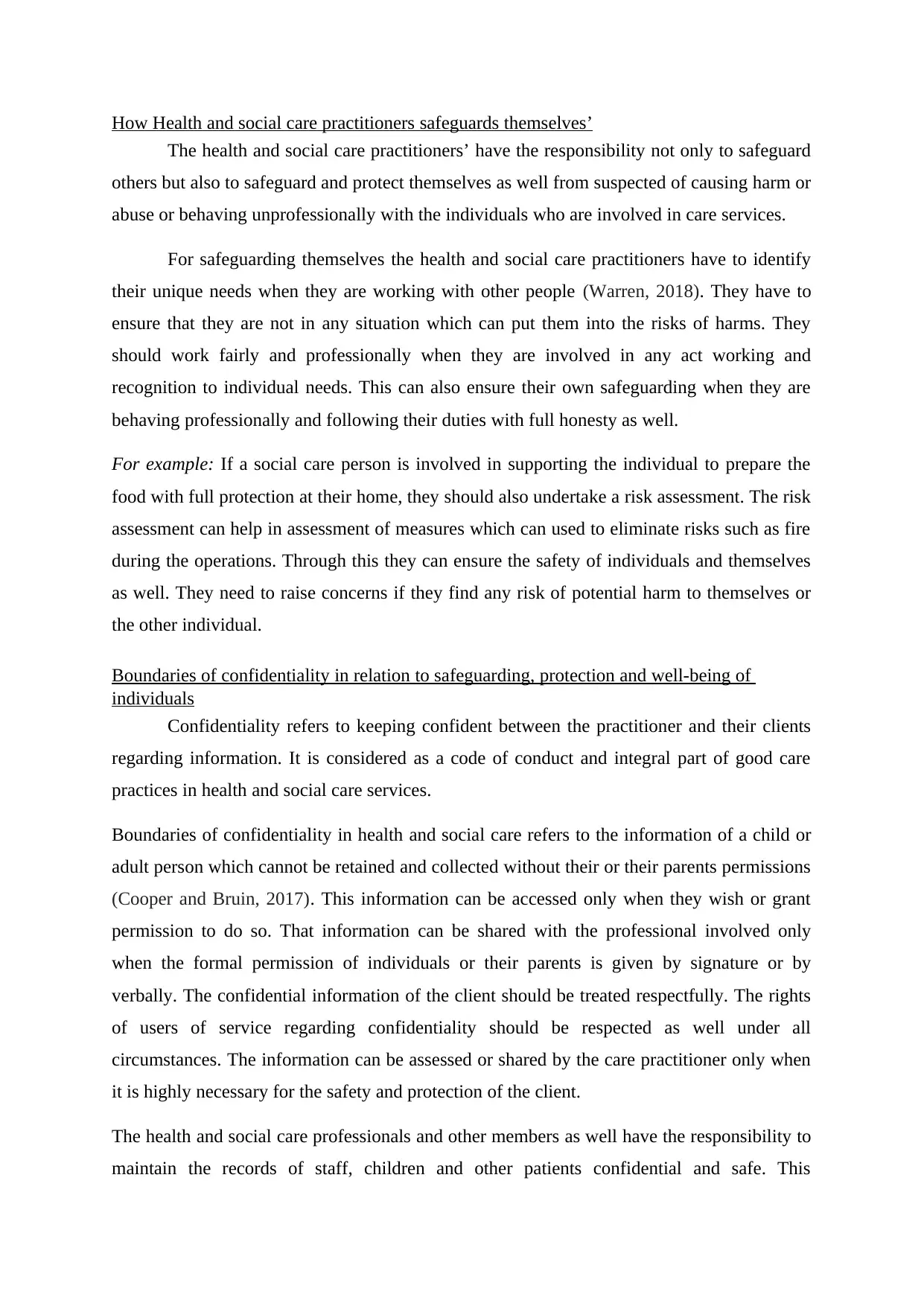
How Health and social care practitioners safeguards themselves’
The health and social care practitioners’ have the responsibility not only to safeguard
others but also to safeguard and protect themselves as well from suspected of causing harm or
abuse or behaving unprofessionally with the individuals who are involved in care services.
For safeguarding themselves the health and social care practitioners have to identify
their unique needs when they are working with other people (Warren, 2018). They have to
ensure that they are not in any situation which can put them into the risks of harms. They
should work fairly and professionally when they are involved in any act working and
recognition to individual needs. This can also ensure their own safeguarding when they are
behaving professionally and following their duties with full honesty as well.
For example: If a social care person is involved in supporting the individual to prepare the
food with full protection at their home, they should also undertake a risk assessment. The risk
assessment can help in assessment of measures which can used to eliminate risks such as fire
during the operations. Through this they can ensure the safety of individuals and themselves
as well. They need to raise concerns if they find any risk of potential harm to themselves or
the other individual.
Boundaries of confidentiality in relation to safeguarding, protection and well-being of
individuals
Confidentiality refers to keeping confident between the practitioner and their clients
regarding information. It is considered as a code of conduct and integral part of good care
practices in health and social care services.
Boundaries of confidentiality in health and social care refers to the information of a child or
adult person which cannot be retained and collected without their or their parents permissions
(Cooper and Bruin, 2017). This information can be accessed only when they wish or grant
permission to do so. That information can be shared with the professional involved only
when the formal permission of individuals or their parents is given by signature or by
verbally. The confidential information of the client should be treated respectfully. The rights
of users of service regarding confidentiality should be respected as well under all
circumstances. The information can be assessed or shared by the care practitioner only when
it is highly necessary for the safety and protection of the client.
The health and social care professionals and other members as well have the responsibility to
maintain the records of staff, children and other patients confidential and safe. This
The health and social care practitioners’ have the responsibility not only to safeguard
others but also to safeguard and protect themselves as well from suspected of causing harm or
abuse or behaving unprofessionally with the individuals who are involved in care services.
For safeguarding themselves the health and social care practitioners have to identify
their unique needs when they are working with other people (Warren, 2018). They have to
ensure that they are not in any situation which can put them into the risks of harms. They
should work fairly and professionally when they are involved in any act working and
recognition to individual needs. This can also ensure their own safeguarding when they are
behaving professionally and following their duties with full honesty as well.
For example: If a social care person is involved in supporting the individual to prepare the
food with full protection at their home, they should also undertake a risk assessment. The risk
assessment can help in assessment of measures which can used to eliminate risks such as fire
during the operations. Through this they can ensure the safety of individuals and themselves
as well. They need to raise concerns if they find any risk of potential harm to themselves or
the other individual.
Boundaries of confidentiality in relation to safeguarding, protection and well-being of
individuals
Confidentiality refers to keeping confident between the practitioner and their clients
regarding information. It is considered as a code of conduct and integral part of good care
practices in health and social care services.
Boundaries of confidentiality in health and social care refers to the information of a child or
adult person which cannot be retained and collected without their or their parents permissions
(Cooper and Bruin, 2017). This information can be accessed only when they wish or grant
permission to do so. That information can be shared with the professional involved only
when the formal permission of individuals or their parents is given by signature or by
verbally. The confidential information of the client should be treated respectfully. The rights
of users of service regarding confidentiality should be respected as well under all
circumstances. The information can be assessed or shared by the care practitioner only when
it is highly necessary for the safety and protection of the client.
The health and social care professionals and other members as well have the responsibility to
maintain the records of staff, children and other patients confidential and safe. This
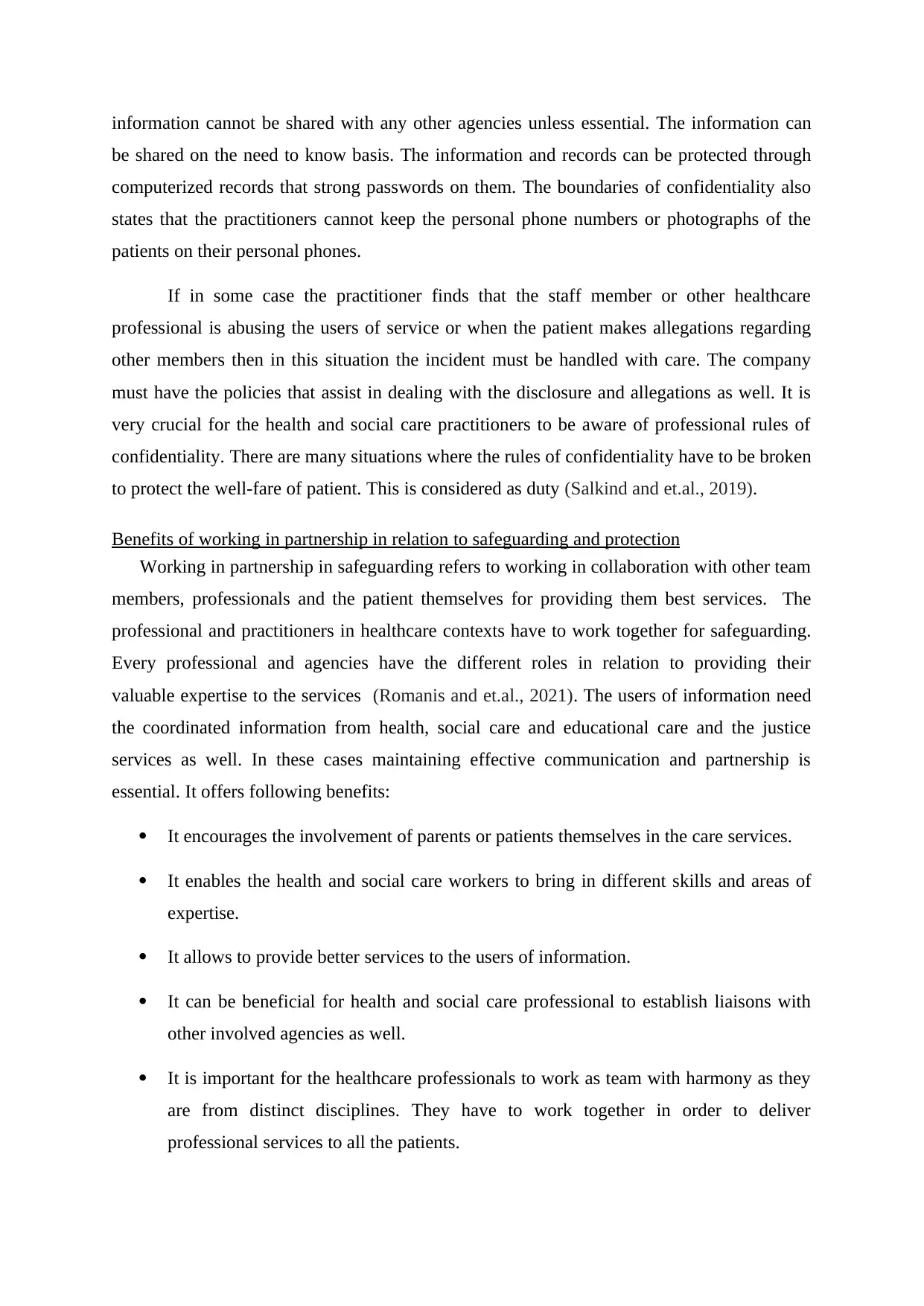
information cannot be shared with any other agencies unless essential. The information can
be shared on the need to know basis. The information and records can be protected through
computerized records that strong passwords on them. The boundaries of confidentiality also
states that the practitioners cannot keep the personal phone numbers or photographs of the
patients on their personal phones.
If in some case the practitioner finds that the staff member or other healthcare
professional is abusing the users of service or when the patient makes allegations regarding
other members then in this situation the incident must be handled with care. The company
must have the policies that assist in dealing with the disclosure and allegations as well. It is
very crucial for the health and social care practitioners to be aware of professional rules of
confidentiality. There are many situations where the rules of confidentiality have to be broken
to protect the well-fare of patient. This is considered as duty (Salkind and et.al., 2019).
Benefits of working in partnership in relation to safeguarding and protection
Working in partnership in safeguarding refers to working in collaboration with other team
members, professionals and the patient themselves for providing them best services. The
professional and practitioners in healthcare contexts have to work together for safeguarding.
Every professional and agencies have the different roles in relation to providing their
valuable expertise to the services (Romanis and et.al., 2021). The users of information need
the coordinated information from health, social care and educational care and the justice
services as well. In these cases maintaining effective communication and partnership is
essential. It offers following benefits:
It encourages the involvement of parents or patients themselves in the care services.
It enables the health and social care workers to bring in different skills and areas of
expertise.
It allows to provide better services to the users of information.
It can be beneficial for health and social care professional to establish liaisons with
other involved agencies as well.
It is important for the healthcare professionals to work as team with harmony as they
are from distinct disciplines. They have to work together in order to deliver
professional services to all the patients.
be shared on the need to know basis. The information and records can be protected through
computerized records that strong passwords on them. The boundaries of confidentiality also
states that the practitioners cannot keep the personal phone numbers or photographs of the
patients on their personal phones.
If in some case the practitioner finds that the staff member or other healthcare
professional is abusing the users of service or when the patient makes allegations regarding
other members then in this situation the incident must be handled with care. The company
must have the policies that assist in dealing with the disclosure and allegations as well. It is
very crucial for the health and social care practitioners to be aware of professional rules of
confidentiality. There are many situations where the rules of confidentiality have to be broken
to protect the well-fare of patient. This is considered as duty (Salkind and et.al., 2019).
Benefits of working in partnership in relation to safeguarding and protection
Working in partnership in safeguarding refers to working in collaboration with other team
members, professionals and the patient themselves for providing them best services. The
professional and practitioners in healthcare contexts have to work together for safeguarding.
Every professional and agencies have the different roles in relation to providing their
valuable expertise to the services (Romanis and et.al., 2021). The users of information need
the coordinated information from health, social care and educational care and the justice
services as well. In these cases maintaining effective communication and partnership is
essential. It offers following benefits:
It encourages the involvement of parents or patients themselves in the care services.
It enables the health and social care workers to bring in different skills and areas of
expertise.
It allows to provide better services to the users of information.
It can be beneficial for health and social care professional to establish liaisons with
other involved agencies as well.
It is important for the healthcare professionals to work as team with harmony as they
are from distinct disciplines. They have to work together in order to deliver
professional services to all the patients.
⊘ This is a preview!⊘
Do you want full access?
Subscribe today to unlock all pages.

Trusted by 1+ million students worldwide
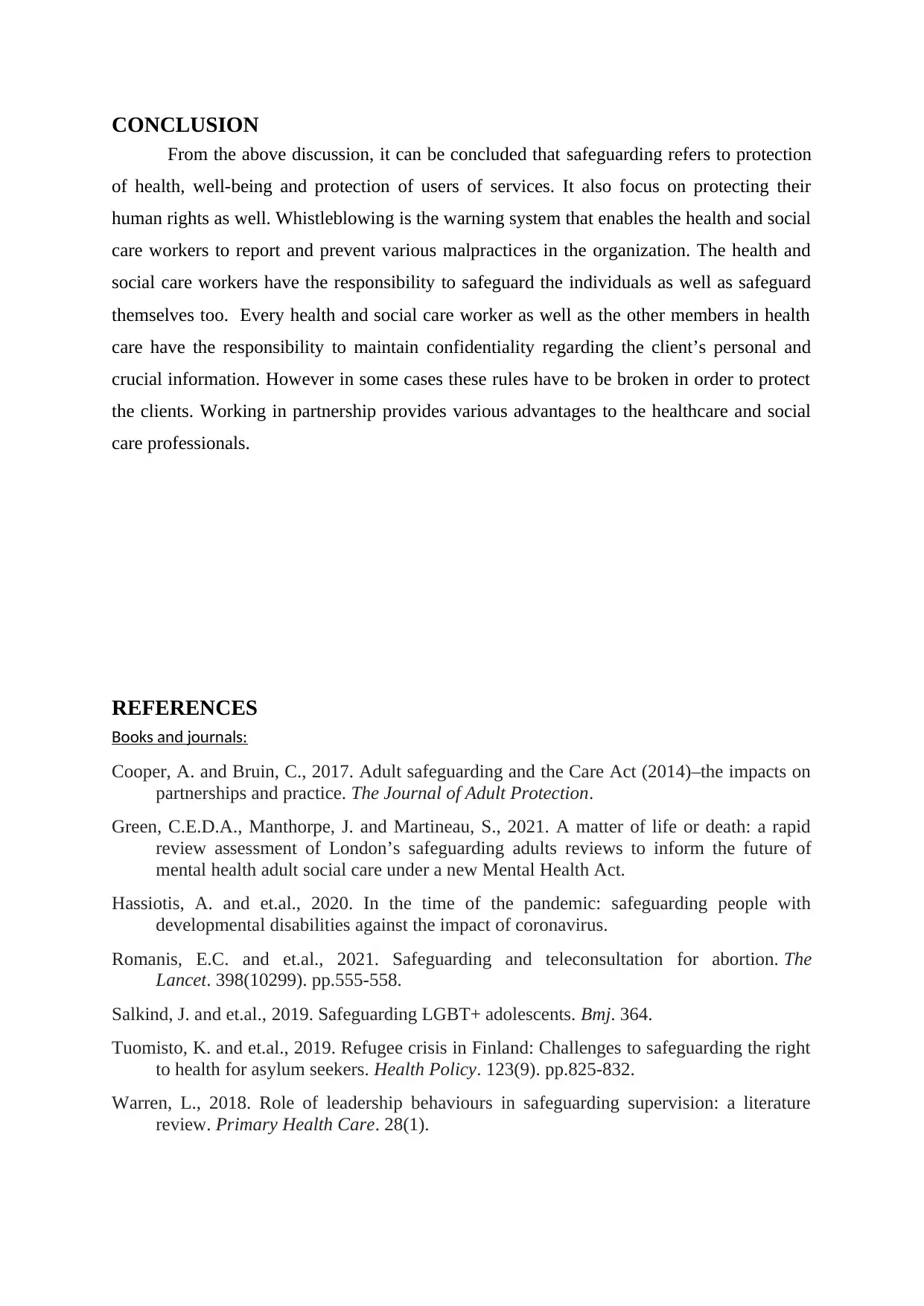
CONCLUSION
From the above discussion, it can be concluded that safeguarding refers to protection
of health, well-being and protection of users of services. It also focus on protecting their
human rights as well. Whistleblowing is the warning system that enables the health and social
care workers to report and prevent various malpractices in the organization. The health and
social care workers have the responsibility to safeguard the individuals as well as safeguard
themselves too. Every health and social care worker as well as the other members in health
care have the responsibility to maintain confidentiality regarding the client’s personal and
crucial information. However in some cases these rules have to be broken in order to protect
the clients. Working in partnership provides various advantages to the healthcare and social
care professionals.
REFERENCES
Books and journals:
Cooper, A. and Bruin, C., 2017. Adult safeguarding and the Care Act (2014)–the impacts on
partnerships and practice. The Journal of Adult Protection.
Green, C.E.D.A., Manthorpe, J. and Martineau, S., 2021. A matter of life or death: a rapid
review assessment of London’s safeguarding adults reviews to inform the future of
mental health adult social care under a new Mental Health Act.
Hassiotis, A. and et.al., 2020. In the time of the pandemic: safeguarding people with
developmental disabilities against the impact of coronavirus.
Romanis, E.C. and et.al., 2021. Safeguarding and teleconsultation for abortion. The
Lancet. 398(10299). pp.555-558.
Salkind, J. and et.al., 2019. Safeguarding LGBT+ adolescents. Bmj. 364.
Tuomisto, K. and et.al., 2019. Refugee crisis in Finland: Challenges to safeguarding the right
to health for asylum seekers. Health Policy. 123(9). pp.825-832.
Warren, L., 2018. Role of leadership behaviours in safeguarding supervision: a literature
review. Primary Health Care. 28(1).
From the above discussion, it can be concluded that safeguarding refers to protection
of health, well-being and protection of users of services. It also focus on protecting their
human rights as well. Whistleblowing is the warning system that enables the health and social
care workers to report and prevent various malpractices in the organization. The health and
social care workers have the responsibility to safeguard the individuals as well as safeguard
themselves too. Every health and social care worker as well as the other members in health
care have the responsibility to maintain confidentiality regarding the client’s personal and
crucial information. However in some cases these rules have to be broken in order to protect
the clients. Working in partnership provides various advantages to the healthcare and social
care professionals.
REFERENCES
Books and journals:
Cooper, A. and Bruin, C., 2017. Adult safeguarding and the Care Act (2014)–the impacts on
partnerships and practice. The Journal of Adult Protection.
Green, C.E.D.A., Manthorpe, J. and Martineau, S., 2021. A matter of life or death: a rapid
review assessment of London’s safeguarding adults reviews to inform the future of
mental health adult social care under a new Mental Health Act.
Hassiotis, A. and et.al., 2020. In the time of the pandemic: safeguarding people with
developmental disabilities against the impact of coronavirus.
Romanis, E.C. and et.al., 2021. Safeguarding and teleconsultation for abortion. The
Lancet. 398(10299). pp.555-558.
Salkind, J. and et.al., 2019. Safeguarding LGBT+ adolescents. Bmj. 364.
Tuomisto, K. and et.al., 2019. Refugee crisis in Finland: Challenges to safeguarding the right
to health for asylum seekers. Health Policy. 123(9). pp.825-832.
Warren, L., 2018. Role of leadership behaviours in safeguarding supervision: a literature
review. Primary Health Care. 28(1).
1 out of 7
Related Documents
Your All-in-One AI-Powered Toolkit for Academic Success.
+13062052269
info@desklib.com
Available 24*7 on WhatsApp / Email
![[object Object]](/_next/static/media/star-bottom.7253800d.svg)
Unlock your academic potential
Copyright © 2020–2025 A2Z Services. All Rights Reserved. Developed and managed by ZUCOL.



